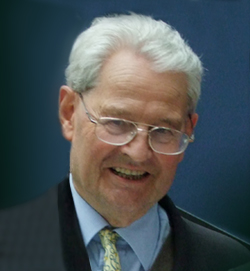Georges Salmer (Director of the IEMN, 1998-2002) recalls his first meeting with Eugène :
"He greeted me with a big smile, busy preparing the lab tea, his lab coat full of holes and brown stains, because of the acid he was studying solutions for his thesis. Afterwards, he guided me decisively for my thesis and I am very grateful to him for that.
This vivid and moving portrait of one of the founders of the IEMN reveals three essential facets of the character: the warm and unifying man who was a young assistant at the time, the researcher with a passion for experienceand the one who can be called the " guide« .
A great laboratory pattern
As the first director of the IEMN, Eugène Constant left a lasting imprint in his leadership of the Institute. The support given to the various categories of staff created buy-in from all to his ideas and projects and recognition for the positions obtained thanks to his determination.
"His office was always open to us," Georges recalls. His office was always open to us," Georges recalls. "His openness and availability certainly predisposed him to be a local manager. Having an entrepreneurial spiritHe had the qualities of a great boss, with a touch of paternalism.
The words that come back to mind in the mouths of those who knew him are "creator, unifier, catalyst". He knew how to coach, listen, convince and decide to build a team around a common goal. His qualities as a coach even went well beyond the strictly professional sphere, as shown by this incident reported by Georges:
"In 1978, he had managed to lead about twenty of us to his second homeland, Oisans (a massif of French Alpes), for a memorable eight-day family tour, punctuated by fatigue and campfires in the snow!
A passionate scientist and a remarkable academic
The image of the radiant student brings out the passionate and stimulating scientist. His doctoral thesis, devoted to molecular dynamics in polar liquids, included very innovative experiments in microwave spectrometry. At that time, Eugene was giving lectures on the conquest of space. His colleagues describe him as an imaginative experimenter:
"In the 1960s, he and Yves Leroy set up a decisively ingenious experiment in infrared spectrometry with a tanning lamp and filter papers. Concerned about consumer applications, he paved the way for microwave thermography, which will be developed by a start-up in Villeneuve d'Ascq for security applications.
In addition, the brilliant researcher was also a great teacher who was much appreciated by his students and young colleagues. He had the remarkable power to convey the physical meaning of the studied phenomena even when they were hidden behind complex equations:
"He'd come out of class with his lab coat and chalk-stained hair, but his students had it all figured out," Georges recalls.
His audience was such that one day, reports Georges, "a specialist in nanocomponents, didn't he declare in front of a delegation of French researchers visiting IBM's research center in the United States, that he owed his vocation to a lecture given by Eugène Constant at a NATO seminar!"
A Guide to the IEMN
The trajectory of the IEMN owes much to the one who will progressively sketch its architecture. He created his own team in 65-66, then worked on setting up structures associated with the CNRS: a Team then an associated Laboratory in 1971 and 1974, which led to the creation of our mixed unit in 1992, the result of the merger of the Laboratoire d'Opto-Acousto-Électronique de Valenciennes, the Institut Supérieur d'Électronique du Nord (ISEN) and the Centre Microfréquences et Semiconducteurs (CHS) being at the initiative of the merger.
From there, the history of the Institute and Eugène's visionary ambition will converge. His intuition and his entrepreneurial abilities will drive two decisive movements for the IEMN. On the one hand, he developed ongoing relations with regional industry. Georges testifies:
"Eugène was a forerunner in opening up the university to the economic world, working from the 1960s with French manufacturers of electronic components LTT and Thomson.
On the other hand, it is working to increase the autonomy of the laboratory. From the 80's, Eugène set himself the goal of developing and mastering of the entire chain of skills ranging from materials, components and microelectronic systems, to metrology and characterization. The autonomy gained through the manufacture of study objects will have a strong impact on the development of numerous research projects in the IEMN.
Alain Cappy (Director of IEMN, 2002-2010) :
"Eugène Constant has been a model for a generation of researchers. He was a high level, accessible scientist who was greatly admired by the physics and technology research community.
Thanks to him, the IEMN has benefited from a creative impulse whose waves are still being felt. He contributed to the expansion of research by cultivating human and scientific potential. Let's hope that he will continue to enlighten our future with his intelligence, his imagination and his permanent optimism.
Writing Karine Perrot (ECM department)














